Ironman Checklist – Must-Do Things During Ironman Race Week
Race weeks can be very stressful. Especially in such complex sport like triathlon that requires some ‘logistics’ and has lots of small details to consider. At this point weeks and months of work have been put into training – for such a long race like Ironman checklist is a great tool to stay organized and avoid forgetting something.
Not planning what to do during the race week itself can result in many last-minute decisions and actions. This will, without a doubt, add unnecessary stress and can even impact the end result on race day.
I think I did pretty well in organizing my race week, so I’m sharing the Ironman checklist I’ve used for my first iron distance triathlon – Ironman Austria.
I’ll definitely come back to this checklist for my future triathlon races as well.
Ironman checklist for the race week
During the race week there’s not much training left to be done, as the body tapers. Having built the habit of constant exercising over the past months, it’s easy to fill all that free time with training.
Avoid doing that and trust the training plan. Training sessions during the Ironman race week should be short and with quick (up to 3-5 minutes) race pace intervals. Otherwise, athletes risk building up fatigue.
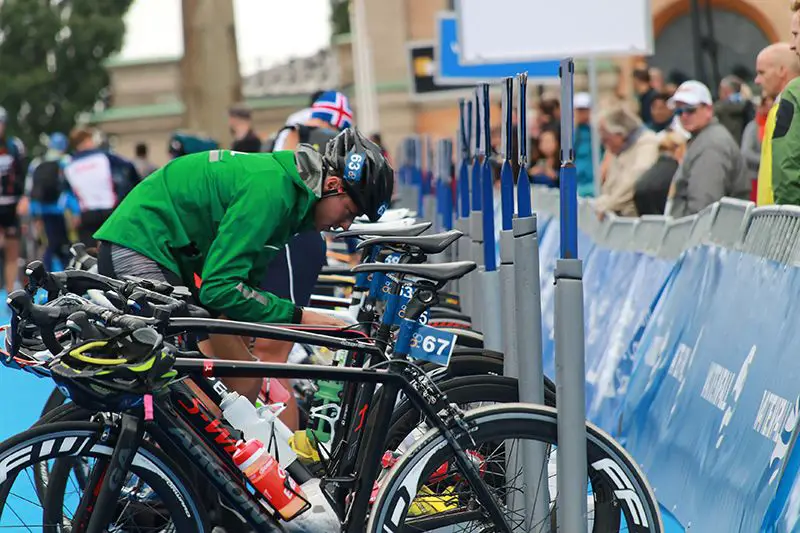
Also, don’t schedule a massage within a week from the race. It puts a lot of pressure on muscles and will require some time to fully recover from. Do that 2-3 weeks before the race and better include a short mobility session every day throughout the race week.
Unless it’s a race-specific ‘energizing’ massage, of course.
The most important thing Ironman athletes can do for recovery during the race week is to ensure they’re sleeping 9 hours every day. After all the training for weeks and months, the body needs as much time as possible in complete peace to recover both the muscle damage and nervous system. Sleep is the most effective way to do it.
Thursday – three days out
Now getting to the actual daily ‘schedule’.
If the race is on Sunday, then Thursday is the day to start active preparation. For some people it might already be a travel day, in which case packing should be done by now.
As I am going by car, Thursday is the ‘prep’ day for me:
- Service the bike. Wash it (clean bikes go faster), lube the chain, check that brakes and shifting work fine (outdoors).
- Pack. Organize all gear, nutrition and other things you’ll need for before, during and after the race. Buy whatever is missing. Also, pack the suitcase (or in my case the car) already today – less things to worry about on the travel day.
- Carb loading. 3 days before the race is the time to gradually start increasing the amount of carbs in the diet. Don’t forget about adding more sodium to the diet to build a reserve of that as well.
- Toe nails. Cut them today, to avoid losing nails after a marathon. If you forget today, you still have 2 days to remember.
Related: My Ironman Packing List – Gear Bags, Essentials And More
In terms of training I took this day easy. A 30min open water swim with a ’30 strokes easy – 30 at race pace’ fartlek in the morning. In the afternoon it was a 30min recovery spin to check the brakes and shifting after washing the bike.

The Resilient Athlete
A Self-Coaching Guide to Next Level Performance in Sports & Life
Are you aiming to become a resilient athlete who is able to withstand any pressure? Be able to jump on any opportunity? Take any challenge life throws at you head on?
Then this book is for you.
Learn moreFriday – two days out
Friday is a big day for me. I need to drive (~ 4 hours) to the race venue and I also aim to complete all the preparation and administrative stuff today.
It’s a packed day, but it’s best to do it all on a Friday, than a day before the race:
- Bike course check. Drive the bike course and take mental (or written) notes of all technical sections – fast and narrow descents, sharp turns, potholes. While you get the best experience doing it on a bike, I’m doing it by car to cover the most distance and avoid mistakes I did in my first triathlon.
- Race registration & expo visit. Better do all the walking today, to avoid spending too much time on your legs right before the race day.
- Organize gear for check-in. Personally, I like to prepare all bags for check in a day in advance. Place all stickers on the bike, helmet and the bags and organize what goes where.
- Charge all devices. That includes also replacing batteries, if needed, in chest strap and power meter. Do it today – in case you forget there’s one more day left to do it.
For training my original plan was to do a short swim session in the morning (15min + 10min of easy balance exercises) and a short 30min brick in the afternoon.
Instead, I was still feeling a bit un-recovered and the weather in Klagenfurt was burning hot, so I took this day easy as well. 20min OW swim before driving to the race venue with some race pace pickups and a short mobility sequence.
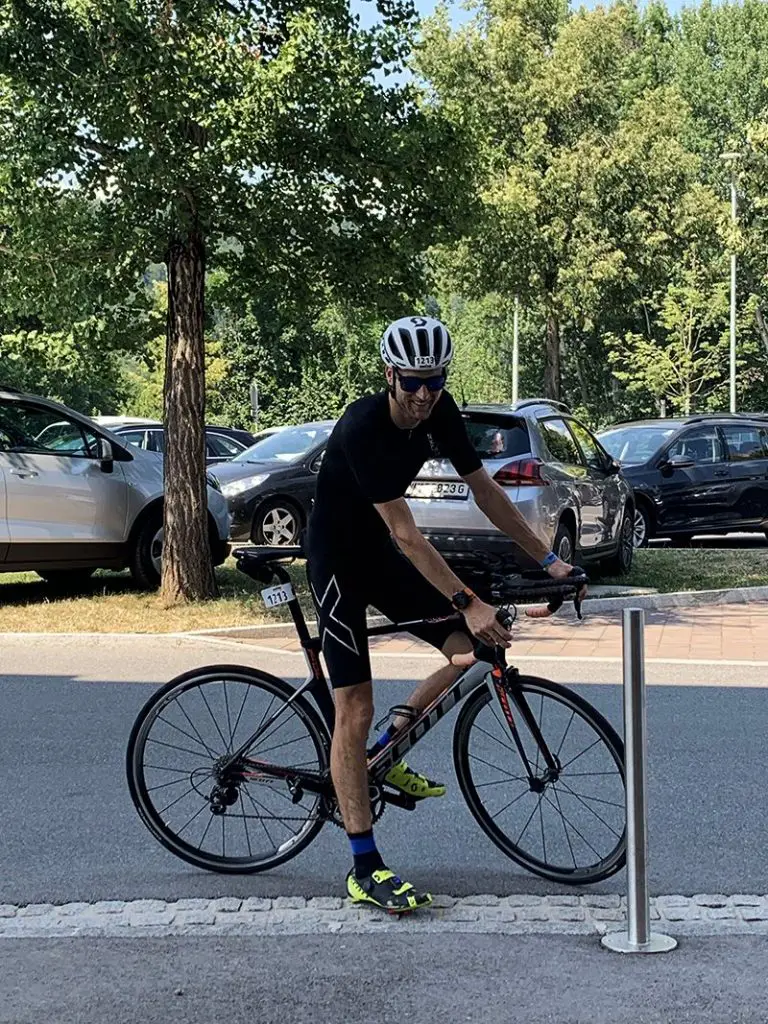
Saturday – one day out
The day before the race should be as relaxing as possible. Almost everything should already be done. Now is the time to read a book, play some games, watch a movie. Just try to take the mind off the race for a while.
My preference is to get back to the hotel as soon as possible and spend the day with my legs up the wall. But before that some administrative things:
- Race briefing. It’s mandatory, but also very informative.
- Bike check-in. Before the check in do a short ride to check the bike condition (to be on the safe side). Once in transition, walk through the area, take pictures to memorize where exactly your bags and the bike are located (to review in the evening and minimize the search time on race day). Also, deflate the tyres a bit for the night – in case there’s a storm they might blow up from the pressure change if pumped up too hard.
- Nutrition and pacing strategy. Once back at the hotel, go through your race strategy one more time and think of issues that might occur and how you’ll deal with them.
- White bag and morning plan. Organize clothing and bag for the morning (nutrition, swim gear, timing chip, etc.).
- Carb-loading. Today focus mostly on complex carbs and try to reduce fiber in the diet. Aim to finish the last meal by 6 p.m. to allow the body to digest the food.
- Relax.
The day before the race I did an easy 15 minute run in the morning with 3 race pace pickups, as well as 15 minute swim on the race course. It was a very hot day, so I was back at the hotel already after 15:00.
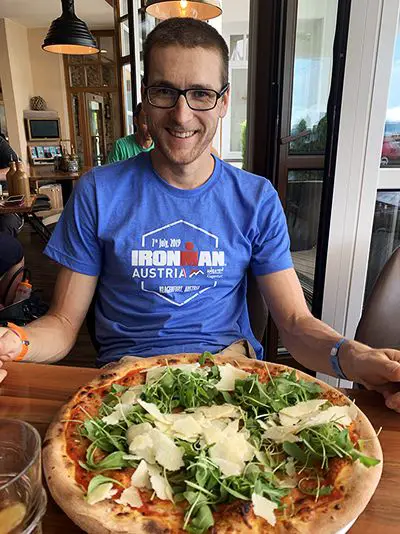
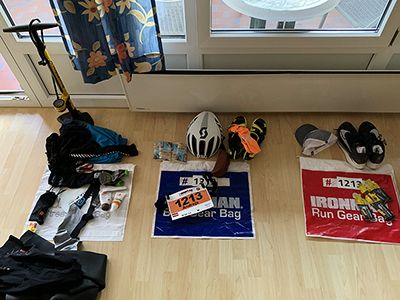
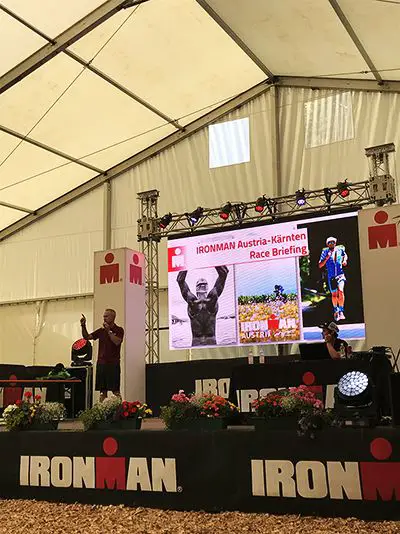
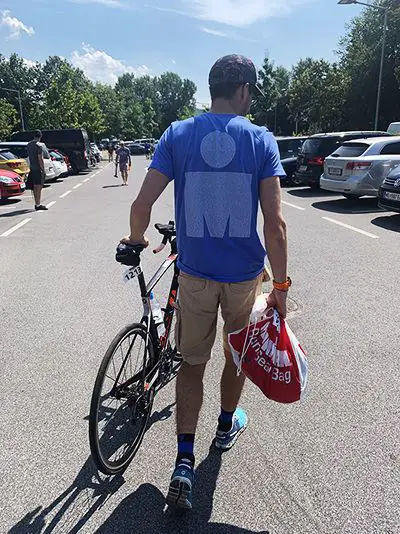
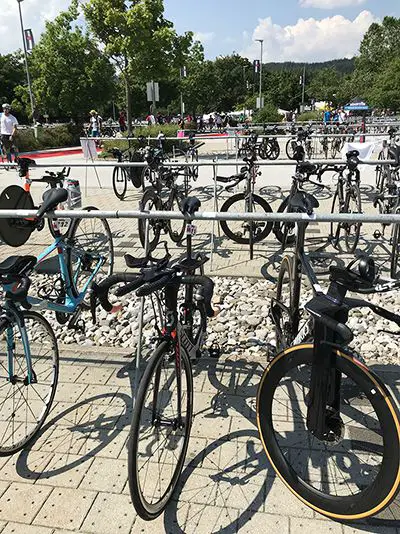
My Ironman checklist for the race day
During the morning of the Ironman checklist is also a great way to stay focused on something besides 226 kilometers that lay between you and the finish line.
I keep my morning routine pretty simple. Just 3 things to focus on:
- Wake up & breakfast. I always wake up 3 hours before the start, get in the cold shower to wake up and start eating breakfast right away. My start is around 6:50 a.m., so I’m aiming to wake up around 3:45 a.m. I’m preparing my own breakfast (overnight oats + energy bar), so that I’m not bound by the hotel schedule.
- Organize nutrition. I don’t pre-mix gels for the bike and run portions the day before and leave them in transition. Instead, I do it in the morning – that way they don’t taste sour from staying in the sun all day.
- Get dressed. Tri-suit, Garmin, chest strap and timing chip.
I also prepare an energy drink with electrolytes that I sip throughout the morning to stay hydrated.
My transition setup plan
Transition area at Ironman Austria opens at 5:15, so I intend to leave around 4:30 a.m. to finish the bike setup with at least an hour left for the warm up. I have a couple of things to do in transition:
- Pump the tyres
- Attach shoes to the pedals and open them wide. I do it in the morning to avoid them getting wet in the rain overnight.
- Double check the bike is in the low gear
- Set up nutrition on the bike, put energy bars in the bike bag and add a bottle with a pre-mixed gel in the run bag.
My warm up process
My warm up is pretty standard and almost automated. As usual, I’ll try to begin with some 5 minutes of activity (easy jog, a walk or some general movement).
After that I’ll do 20 minutes of specific mobility movement and muscle activation activities and finish off with a short swim with some race pace 20-stroke pick ups.
After that I’ll eat a gel, put on the sunscreen and go into the start area.
Did you find this information useful? Share the post with others using the buttons below.
Andrejs
Related Posts
1 Comment
Leave a Reply Cancel reply
GET A FREE TRAINING PLAN
Subscribe to my email list and get access to a free 4-week “back in shape” training plan
You’ll also get two full-body strength sessions and some other goodies!

How did I get here?
Hey there! My name is Andrejs and I am here to inspire, entertain and get you fit for any adventure.
I went from being an over trained pro athlete to an endurance coach sharing how to listen to your body and live life to the fullest.
Traveling, new sports & activities brought new meaning to my training and made it much more effective, fun and enjoyable. And I'm here to help you do the same.

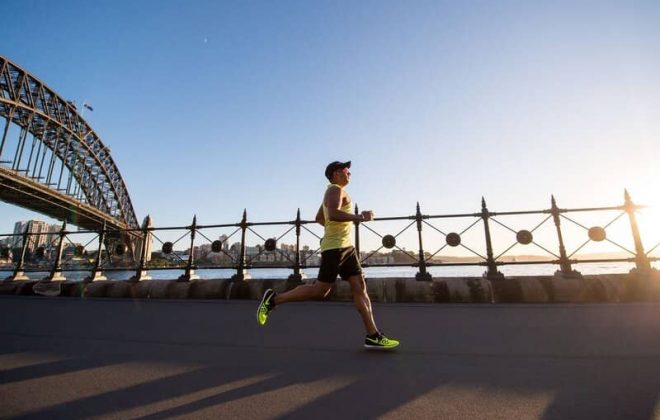

Dear Andrejs,
I found your checklist via a Google search and found it to be very useful and really beautifully formatted. Thanks for sharing it. l served as the head scientist for the National Russian Triathlon Team (2009-2016).
I have passed on it to some of my friends who are active athletes and who are going to participate at Ironman as well after COVID-19.
I like the checklist approach in general and I try to publish my checklists regularly on the Zihi Checklists platform. I post there often in my professional sphere, endurance sports training, and performance. Have you heard about Zihi Checklists? In fact, it’s one of the largest public databases of checklists and packing lists.
If you have a moment, please check it out and maybe even post a checklist or two 🙂 I have no doubt that your experience is valuable and that the Zihi Checklists community would benefit from it ! Thanks again.
PS
My last checklists “Half-marathon running. Pre-race day checklist” is here:
https://zihichecklists.com/checklists/checklist/243
Sincerely
Egor